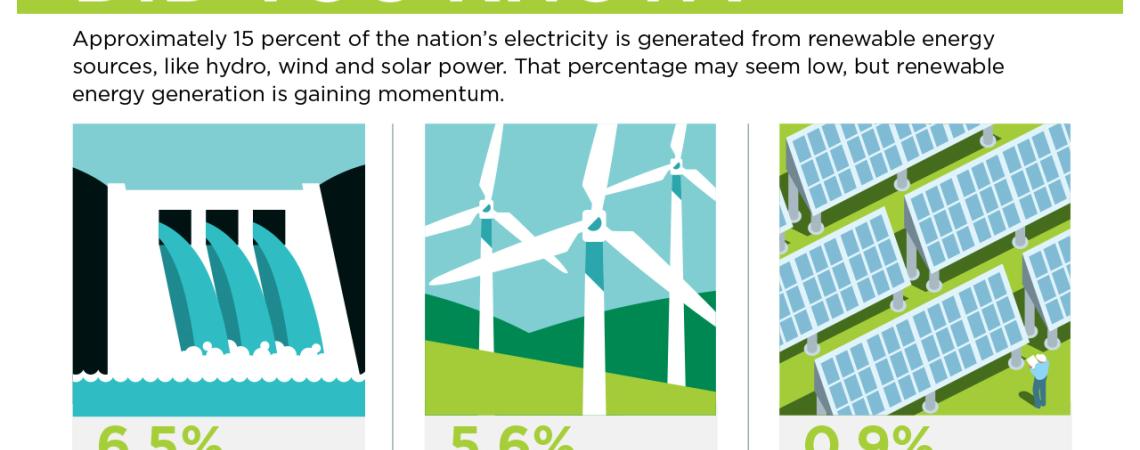Renewables are an increasingly large part of America’s energy mix.
Electric cooperatives work hard to ensure their members have access to the cleanest, safest, most affordable and reliable power possible. They keep up with both technology and trends to maintain that balance through sunny, hot summers; gray, bone-chilling winters; and everything in between.
These days, renewable sources such as solar energy and wind power are growing in popularity, though they still make up a pretty small portion of the energy sources that generate the electricity we use every day — about 6 percent of the energy consumed by Ohio electric cooperative members — because they still provide neither the affordability nor the reliability to balance the other demands.
Here’s a crash course in how wind, the sun, and water generate electricity.
Solar energy
Solar energy generates only about 1 percent of the nation’s electricity, though that’s a significant increase from just five years ago, when the number was too small even to report for the U.S. Department of Energy. Solar growth is expected to continue as long as costs fall, technology improves, and people figure out better ways to use solar energy.
In photovoltaic generation, when certain materials get hit by sunlight, their atoms spit out electrons — and electricity is simply a stream of electrons. Wafers of these materials, called photovoltaic cells, are combined and integrated into solar photovoltaic modules to harness the energy in that stream.
Solar power is produced in different levels: Utility scale refers to large banks of solar panels owned and operated by an electric utility or other large organization, producing many megawatts of solar energy. Industrial solar installations can range from several kilowatts up to multi-megawatts, and can be placed on office rooftops, over parking lots, or on land near industrial and commercial enterprises. Residential solar installations are installed primarily on individual rooftops to power individual homes. Community solar allows groups of neighbors to take advantage of a larger scale they wouldn’t otherwise be able to access.
Community solar, which is offered by many of Ohio’s electric cooperatives, can ease the higher expense of self-owned rooftop solar. The co-op builds a large solar installation and sells shares in the project to members interested in an investment in renewable energy. It allows a homeowner to avoid both maintenance of their own system and the hassle of sorting out different offers from rooftop solar vendors.
Wind power
Use of wind power has increased significantly as costs have decreased. Wind power generates nearly 6 percent of the nation’s electricity.
In a way, wind generates electricity the same way as traditional sources such as coal (which is the source of about 93 percent of power used by Ohio co-op members): by spinning a turbine that creates an electricity-producing magnetic field. The difference is that wind turbines are turned by enormous propeller-like blades designed to catch gusts of moving air. Obviously, they require wind to generate power, and so can’t be counted upon from one day to the next.
Hydroelectric power
Another way to turn an electricity-generating turbine is to harness the power of water as it flows. It doesn’t create greenhouse gas or other chemical pollutants by burning fossil fuel, though large-scale hydro typically calls for building a permanent dam across a river valley and flooding the area behind it.
Another option is to put hydroelectric generators directly in rapidly flowing rivers to capture power — Ohio cooperatives use 55 megawatts of power from the turbines underneath Niagara Falls, for example; it’s about 4 percent of the power used by cooperative members in Ohio every day.
Paul Wesslund writes on cooperative issues for the National Rural Electric Cooperative Association.









